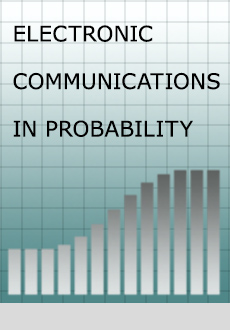Abstract
There are two types of particles interacting on a homogeneous tree of degree $d+1$. The particles of the first type colonize the empty space with exponential rate 1, but cannot take over the vertices that are occupied by the second type. The particles of the second type spread with exponential rate $\lambda$. They colonize the neighboring vertices that are either vacant or occupied by the representatives of the opposite type, and annihilate the particles of the type 1 as they reach them. There exists a critical value $\lambda_c=(2d-1)+\sqrt{(2d-1)^2-1}$ such that the first type survives with positive probability for $\lambda < \lambda_c$, and dies out with probability one for $\lambda > \lambda_c$. We also find the growth profile which characterizes the rate of growth of the type 1 in the space-time on the event of survival.
Citation
George Kordzakhia. "The Escape Model on a Homogeneous Tree." Electron. Commun. Probab. 10 113 - 124, 2005. https://doi.org/10.1214/ECP.v10-1140
Information





